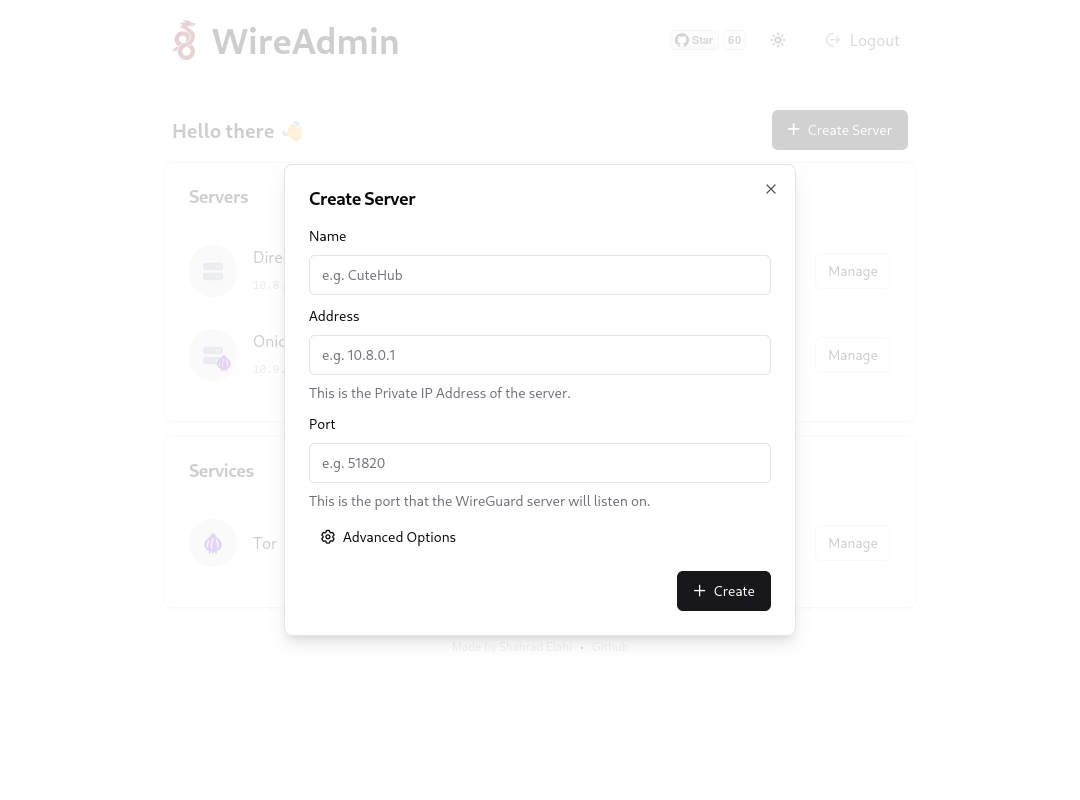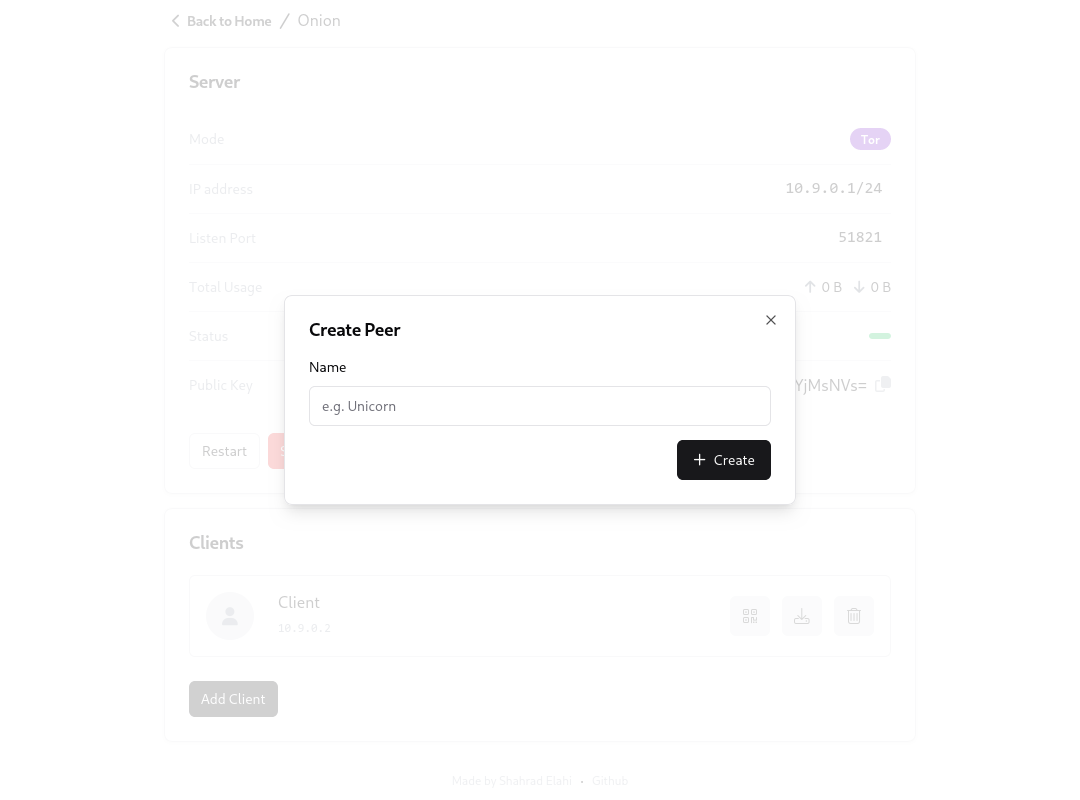# WireGuard (Easy Admin UI)
[](https://github.com/wireadmin/wireadmin/actions/workflows/ci.yml)
[](https://opensource.org/licenses/GPL-3.0)

| | | |
| :----------------------------------------------------------------------------------------: | :----------------------------------------------------------------------------------------: | :----------------------------------------------------------------------------------------: |
|  |
|  |
|  |
---
- [Features](#features)
- [Build locally](#build-locally)
- [Image](#image)
- [Ports](#ports)
- [Usage](#usage)
- [Docker Compose](#docker-compose)
- [Command line](#command-line)
- [Persistent Data](#persistent-data)
- [Environment variables](#environment-variables)
- [Upgrade](#upgrade)
- [Contributing](#contributing)
- [License](#license)
## Features
- Simple and friendly UI
- Support for multiple users and servers
- Support for **Tor for anonymized connections**
- Server connection statistics
- List, create, delete, or modify any server or user
- Create QR codes
- Easily download the client configurations.
- Automatic Light/Dark Mode
## Image
| Registry | Image |
| ------------------------------------------------------------------------------------------------------- | ----------------------------- |
| [GitHub Container Registry](https://github.com/users/shahradelahi/packages/container/package/cfw-proxy) | `ghcr.io/wireadmin/wireadmin` |
## Ports
- `3000`: WebUI
And for any additional ports of WireGuard instance, should be exposed through Docker.
## Usage
### Docker Compose
Docker compose is the recommended way to run this image. You can use the following
[docker compose template](docker-compose.yml), then run the container:
```bash
docker compose up -d
docker compose logs -f
```
### Command line
```shell
$ docker run -d \
--name wireadmin \
-e WG_HOST= \
ADMIN_PASSWORD= \
"3000:3000/tcp" \
-p "51820:51820/udp" \
--cap-add=NET_ADMIN \
--cap-add=SYS_MODULE \
--sysctl="net.ipv4.conf.all.src_valid_mark=1" \
--sysctl="net.ipv4.ip_forward=1" \
ghcr.io/wireadmin/wireadmin < YOUR_SERVER_IP > -e < ADMIN_PASSWORD > -p
```
> 💡 Replace `` with the IP address of your server.
> 💡 Replace `` with the password for the admin UI.
The Web UI will now be available on `http://0.0.0.0:3000`.
### Persistent Data
WireAdmin store configurations at `/data`. It's important to mount a volume at this location to ensure that
your data is not lost during container restarts or updates.
To create a docker volume, use the following command:
```bash
docker volume create wireadmin-data --driver local
```
### Environment variables
These options can be configured by setting environment variables using `-e KEY="VALUE"` in the `docker run` command.
| Option | Description | Default | Optional |
| ----------------- | ----------------------------------------------------------------------------------- | ------------------- | -------- |
| `WG_HOST` | The public IP address of the WireGuard server. | - | |
| `ADMIN_PASSWORD` | The password for the admin UI. | `insecure-password` | |
| `HOST` | The hostname for the WebUI. | `127.0.0.1` | ✔️ |
| `PORT` | The port for the WebUI. | `3000` | ✔️ |
| `TOR_USE_BRIDGES` | Set this to `1` and then mount the bridges file at `/etc/tor/torrc.d/bridges.conf`. | - | ✔️ |
| `TOR_*` | The `Torrc` proxy configuration. (e.g. `SocksPort` as `TOR_SOCKS_PORT="9050"`) | - | ✔️ |
## Upgrade
Recreate the container whenever I push an update:
```bash
docker compose pull
docker compose up -d
```
## Contributing
Want to contribute? Awesome! To show your support is to star the project, or to raise issues
on [GitHub](https://github.com/shahradelahi/docker-cfw-proxy).
Thanks again for your support, it is much appreciated! 🙏
## License
[GPL-3.0](/LICENSE) © [Shahrad Elahi](https://github.com/shahradelahi)
|
---
- [Features](#features)
- [Build locally](#build-locally)
- [Image](#image)
- [Ports](#ports)
- [Usage](#usage)
- [Docker Compose](#docker-compose)
- [Command line](#command-line)
- [Persistent Data](#persistent-data)
- [Environment variables](#environment-variables)
- [Upgrade](#upgrade)
- [Contributing](#contributing)
- [License](#license)
## Features
- Simple and friendly UI
- Support for multiple users and servers
- Support for **Tor for anonymized connections**
- Server connection statistics
- List, create, delete, or modify any server or user
- Create QR codes
- Easily download the client configurations.
- Automatic Light/Dark Mode
## Image
| Registry | Image |
| ------------------------------------------------------------------------------------------------------- | ----------------------------- |
| [GitHub Container Registry](https://github.com/users/shahradelahi/packages/container/package/cfw-proxy) | `ghcr.io/wireadmin/wireadmin` |
## Ports
- `3000`: WebUI
And for any additional ports of WireGuard instance, should be exposed through Docker.
## Usage
### Docker Compose
Docker compose is the recommended way to run this image. You can use the following
[docker compose template](docker-compose.yml), then run the container:
```bash
docker compose up -d
docker compose logs -f
```
### Command line
```shell
$ docker run -d \
--name wireadmin \
-e WG_HOST= \
ADMIN_PASSWORD= \
"3000:3000/tcp" \
-p "51820:51820/udp" \
--cap-add=NET_ADMIN \
--cap-add=SYS_MODULE \
--sysctl="net.ipv4.conf.all.src_valid_mark=1" \
--sysctl="net.ipv4.ip_forward=1" \
ghcr.io/wireadmin/wireadmin < YOUR_SERVER_IP > -e < ADMIN_PASSWORD > -p
```
> 💡 Replace `` with the IP address of your server.
> 💡 Replace `` with the password for the admin UI.
The Web UI will now be available on `http://0.0.0.0:3000`.
### Persistent Data
WireAdmin store configurations at `/data`. It's important to mount a volume at this location to ensure that
your data is not lost during container restarts or updates.
To create a docker volume, use the following command:
```bash
docker volume create wireadmin-data --driver local
```
### Environment variables
These options can be configured by setting environment variables using `-e KEY="VALUE"` in the `docker run` command.
| Option | Description | Default | Optional |
| ----------------- | ----------------------------------------------------------------------------------- | ------------------- | -------- |
| `WG_HOST` | The public IP address of the WireGuard server. | - | |
| `ADMIN_PASSWORD` | The password for the admin UI. | `insecure-password` | |
| `HOST` | The hostname for the WebUI. | `127.0.0.1` | ✔️ |
| `PORT` | The port for the WebUI. | `3000` | ✔️ |
| `TOR_USE_BRIDGES` | Set this to `1` and then mount the bridges file at `/etc/tor/torrc.d/bridges.conf`. | - | ✔️ |
| `TOR_*` | The `Torrc` proxy configuration. (e.g. `SocksPort` as `TOR_SOCKS_PORT="9050"`) | - | ✔️ |
## Upgrade
Recreate the container whenever I push an update:
```bash
docker compose pull
docker compose up -d
```
## Contributing
Want to contribute? Awesome! To show your support is to star the project, or to raise issues
on [GitHub](https://github.com/shahradelahi/docker-cfw-proxy).
Thanks again for your support, it is much appreciated! 🙏
## License
[GPL-3.0](/LICENSE) © [Shahrad Elahi](https://github.com/shahradelahi)
 |
|  |
|  |
---
- [Features](#features)
- [Build locally](#build-locally)
- [Image](#image)
- [Ports](#ports)
- [Usage](#usage)
- [Docker Compose](#docker-compose)
- [Command line](#command-line)
- [Persistent Data](#persistent-data)
- [Environment variables](#environment-variables)
- [Upgrade](#upgrade)
- [Contributing](#contributing)
- [License](#license)
## Features
- Simple and friendly UI
- Support for multiple users and servers
- Support for **Tor for anonymized connections**
- Server connection statistics
- List, create, delete, or modify any server or user
- Create QR codes
- Easily download the client configurations.
- Automatic Light/Dark Mode
## Image
| Registry | Image |
| ------------------------------------------------------------------------------------------------------- | ----------------------------- |
| [GitHub Container Registry](https://github.com/users/shahradelahi/packages/container/package/cfw-proxy) | `ghcr.io/wireadmin/wireadmin` |
## Ports
- `3000`: WebUI
And for any additional ports of WireGuard instance, should be exposed through Docker.
## Usage
### Docker Compose
Docker compose is the recommended way to run this image. You can use the following
[docker compose template](docker-compose.yml), then run the container:
```bash
docker compose up -d
docker compose logs -f
```
### Command line
```shell
$ docker run -d \
--name wireadmin \
-e WG_HOST= \
ADMIN_PASSWORD= \
"3000:3000/tcp" \
-p "51820:51820/udp" \
--cap-add=NET_ADMIN \
--cap-add=SYS_MODULE \
--sysctl="net.ipv4.conf.all.src_valid_mark=1" \
--sysctl="net.ipv4.ip_forward=1" \
ghcr.io/wireadmin/wireadmin < YOUR_SERVER_IP > -e < ADMIN_PASSWORD > -p
```
> 💡 Replace `
|
---
- [Features](#features)
- [Build locally](#build-locally)
- [Image](#image)
- [Ports](#ports)
- [Usage](#usage)
- [Docker Compose](#docker-compose)
- [Command line](#command-line)
- [Persistent Data](#persistent-data)
- [Environment variables](#environment-variables)
- [Upgrade](#upgrade)
- [Contributing](#contributing)
- [License](#license)
## Features
- Simple and friendly UI
- Support for multiple users and servers
- Support for **Tor for anonymized connections**
- Server connection statistics
- List, create, delete, or modify any server or user
- Create QR codes
- Easily download the client configurations.
- Automatic Light/Dark Mode
## Image
| Registry | Image |
| ------------------------------------------------------------------------------------------------------- | ----------------------------- |
| [GitHub Container Registry](https://github.com/users/shahradelahi/packages/container/package/cfw-proxy) | `ghcr.io/wireadmin/wireadmin` |
## Ports
- `3000`: WebUI
And for any additional ports of WireGuard instance, should be exposed through Docker.
## Usage
### Docker Compose
Docker compose is the recommended way to run this image. You can use the following
[docker compose template](docker-compose.yml), then run the container:
```bash
docker compose up -d
docker compose logs -f
```
### Command line
```shell
$ docker run -d \
--name wireadmin \
-e WG_HOST= \
ADMIN_PASSWORD= \
"3000:3000/tcp" \
-p "51820:51820/udp" \
--cap-add=NET_ADMIN \
--cap-add=SYS_MODULE \
--sysctl="net.ipv4.conf.all.src_valid_mark=1" \
--sysctl="net.ipv4.ip_forward=1" \
ghcr.io/wireadmin/wireadmin < YOUR_SERVER_IP > -e < ADMIN_PASSWORD > -p
```
> 💡 Replace `